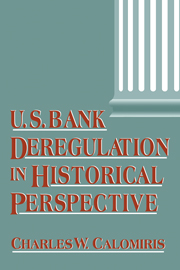Book contents
- Frontmatter
- Contents
- Acknowledgments
- Introduction
- 1 Regulation, industrial structure, and instability in U.S. banking: An historical perspective
- 2 The origins of banking panics: Models, facts, and bank regulation (with Gary Gorton)
- 3 The origins of federal deposit insurance (with Eugene N. White)
- 4 The costs of rejecting universal banking: American finance in the German mirror
- 5 The evolution of market structure, information, and spreads in American investment banking (with Daniel M. G. Raff)
- 6 Universal banking, “American style”
- General Index
- Index of Names
1 - Regulation, industrial structure, and instability in U.S. banking: An historical perspective
Published online by Cambridge University Press: 11 September 2009
- Frontmatter
- Contents
- Acknowledgments
- Introduction
- 1 Regulation, industrial structure, and instability in U.S. banking: An historical perspective
- 2 The origins of banking panics: Models, facts, and bank regulation (with Gary Gorton)
- 3 The origins of federal deposit insurance (with Eugene N. White)
- 4 The costs of rejecting universal banking: American finance in the German mirror
- 5 The evolution of market structure, information, and spreads in American investment banking (with Daniel M. G. Raff)
- 6 Universal banking, “American style”
- General Index
- Index of Names
Summary
Introduction
From the mid-1930s through the 1970s the fundamental institutional and regulatory features of the U.S. banking system were taken for granted as permanent and mainly beneficial by most policymakers and economists. Various aspects of the regulatory system (particularly reserve requirements and deposit interest rate ceilings) were blamed for inefficiencies in capital market allocation by banks and often were seen as an impetus for financial innovations in and outside of banking: for example, NOW accounts, and the growth of credit unions and money market mutual funds. But much of the regulatory structure was seen as benign or beneficial. Studies of economies of scale in banking seemed to indicate that unit banking restrictions had little economic impact on bank efficiency. The stability of the commercial banking system seemed to have been ensured by the regulatory “safety net,” including federal and state deposit insurance program that removed depositors' incentives to run on their banks in response to adverse economic news, and by regulations on bank operations – notably, the separation of commercial and investment banking, justified in 1933 as a means to prevent dishonest or reckless practices by banks.
In retrospect, the faith in the post-Depression regulated system's ability to deliver bank stability is understandable given the unusual calm of the period from 1934 to 1980. Systemic banking panics or waves of bank failures had become a distant memory, easily attributable to a primitive state of affairs prior to the supposed rationalization of banking brought by the Depression-era reform.
- Type
- Chapter
- Information
- U.S. Bank Deregulation in Historical Perspective , pp. 1 - 92Publisher: Cambridge University PressPrint publication year: 2000
- 10
- Cited by



